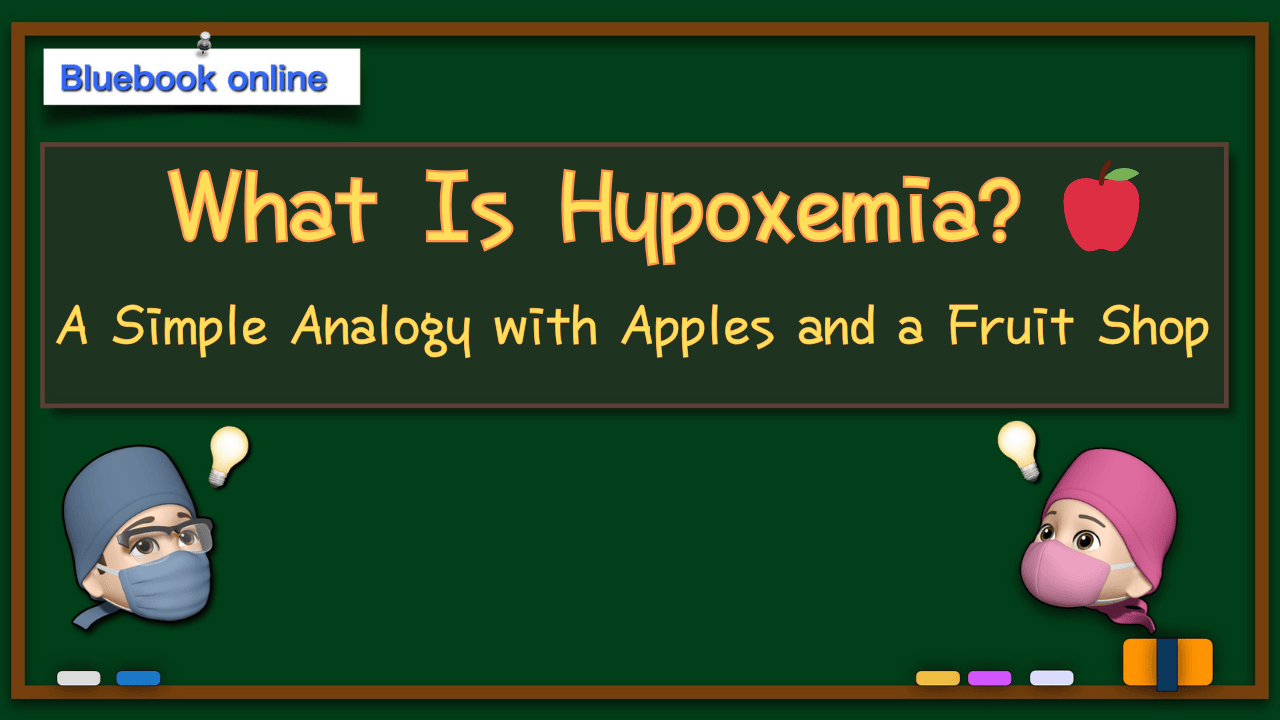👉👉 🇺🇸 All Posts 🇬🇧 / 🇯🇵 記事一覧 🇯🇵 👈👈
Hypoxemia—what does it mean?
Put very simply, hypoxemia is “low oxygen in the blood.” But here’s the tricky part: low does not always mean insufficient.
By definition, hypoxemia refers to a PaO₂ less than 60 mmHg. Importantly, this is not a disease name but a state. The underlying causes can be very different, and so can the appropriate management.
Also, let’s clarify:
- Hypoxemia = low oxygen in the blood
- Hypoxia = low oxygen at the tissue level
Hypoxemia may cause hypoxia, but they are not synonymous. That distinction is clinically important.
Why do we even need oxygen?
Not just “because it feels bad when we’re short of breath.” That feeling of breathlessness is only a signal to make us breathe more.
The real reason: cells need energy in the form of ATP (adenosine triphosphate), and oxygen is essential for producing ATP efficiently. Since oxygen cannot be stored in large amounts, organisms like us must continuously breathe it in to survive.
An analogy: Running a fruit shop 🍎
Imagine you own a fruit shop (your cells) that sells apples (oxygen). But your apples are almost sold out! You place an order with the farmer (the respiratory center in the brain).
Apples are shipped by airplane (breathing), delivered to the local warehouse (the lungs) via a special road (the airway), and then transported by trucks (red blood cells with hemoglobin) along the highway (blood vessels) to reach your shop.
If any of these processes fail, hypoxemia—or cellular oxygen shortage—may occur. Let’s break it down step by step.
🔷 Hypoventilation (Part 1: Depressed drive) 🧠
The respiratory center in the brain acts like the farmer sending apples (O₂). If the farmer is “on strike,” not enough planes fly in.
This occurs when the drive to breathe is suppressed, such as:
- General anesthesia or sedatives
- Opioid analgesics
- Brainstem lesions or neuromuscular weakness
Result: not enough oxygen even reaches the lungs in the first place.
👉 “The apples aren’t even arriving at the airport!”
🔷 Hypoventilation (Part 2: Airway obstruction)🛣️
Here, the breathing effort exists, but the road (airway) is blocked.
Examples:
- Obstructive sleep apnea (OSA) – recurrent upper airway collapse
- Perioperative airway obstruction – tongue, soft tissue collapse after anesthesia
- Severe asthma or COPD exacerbation – narrowed airways restricting flow
👉 “The apples are shipped but stuck in a traffic jam before reaching the warehouse.”
🔷 Impaired Oxygenation (Lung problem)🫁
The apples reach the warehouse (lungs), but gas exchange fails. Oxygen molecules cannot cross into blood effectively.
Major causes include:
- Pneumonia → inflammatory exudate filling alveoli
- Pulmonary edema → alveoli “waterlogged,” O₂ can’t diffuse
- Atelectasis → alveoli collapse, reducing surface area
- ARDS → diffuse alveolar damage with shunt physiology
👉 “The warehouse is damaged or flooded, so apples can’t be shipped.”
🔷 Transport Impairment (Blood/Heart problem) 🚚
Oxygen leaves the lungs but isn’t delivered properly.
This happens when:
- Anemia → fewer red blood cells or hemoglobin molecules (fewer trucks)
- Heart failure → reduced cardiac output, tissues under-delivered
- Circulatory shock → systemic delivery collapse
👉 “There aren’t enough trucks, or traffic is too slow, so apples don’t reach the shop in time.”
🔷 Utilization Impairment (Poisoning) 😱
Even when oxygen arrives, cells may be unable to use it.
Classic examples:
- Carbon monoxide poisoning → CO binds Hb with 200× higher affinity than O₂, reducing both oxygen transport and tissue release
- Cyanide poisoning → blocks cytochrome oxidase in mitochondria, preventing oxidative phosphorylation
👉 “Apples were delivered but stolen or rendered useless before reaching the shop.”
(Strictly speaking, CO poisoning is both transport and utilization impairment, but for teaching, we group it here.)
📝 Summary
The detailed mechanisms of hypoxemia are more complex, but this analogy offers a first step in understanding:
- Hypoventilation: oxygen doesn’t reach the lungs (e.g., opioids, sleep apnea)
- Impaired Oxygenation: lung problem (e.g., pneumonia, pulmonary edema)
- Transport Impairment: not enough trucks (e.g., anemia, heart failure)
- Utilization Impairment: oxygen can’t be used (e.g., CO or cyanide poisoning)
In perioperative settings, hypoventilation and oxygenation impairment are the most common. Hypoxemia is not a diagnosis but a state, and identifying the underlying cause is essential for timely management.
🔗 Related articles
- coming soon
